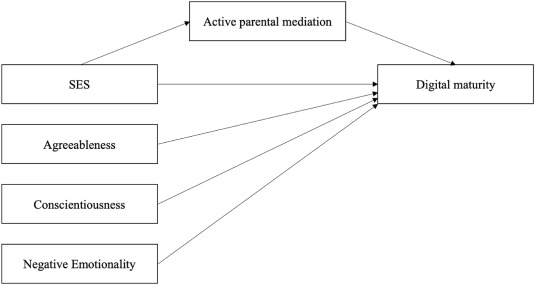Research conducted by a team of researchers from the EU-funded DIGYMATEX project at the University of Vienna has shown that active parental involvement in adolescents’ use of digital devices has a positive effect on their digital maturity. The research shows that adolescents from families with higher socioeconomic backgrounds have higher levels of digital maturity, and that this effect can be fully explained by active parental involvement.
Active parental mediation means that parents are involved in their child’s use of digital devices, explain the risks and benefits, and encourage exploration. The findings suggest that parents with higher socioeconomic backgrounds are more likely to engage in this behavior, which benefits adolescents.
Interestingly, the extent to which parents engage in restrictive practices, such as limiting screen time or certain online activities, did not relate to socioeconomic background or adolescents’ digital maturity. This suggests that restrictive parental practices neither positively nor negatively relate to digital maturity.
The research also shows that adolescents’ personality traits relate to their digital maturity. In particular, high agreeableness (on the part of teenagers), high conscientiousness and low negative emotionality are positively related to digital maturity.
This supports the notion that personality influences the acquisition of life skills, independent of socioeconomic status and parental involvement, including in the digital context.
The research paper, titled “Socioeconomic status and young people’s digital maturity: The role of parental mediation”, by Teresa Koch, Franziska Laaber and Arnd Florack of the University of Vienna’s Department of Occupational, Economic and Social Psychology, will be published in the May 2024 issue of Computers in Human Behavior and has been available online since February 5.
“Overall, the present study makes an important contribution to the literature by investigating digital maturity as a broad underlying capability for beneficial device use that benefits personal development and integration into society,” the researchers said.
“By investigating environmental and personality factors associated with digital maturity, the article provides valuable insights into the development of beneficial use behaviors that can be built upon to promote young people’s beneficial and mature use of digital devices for personal advancement,” the researchers added.
In this way, the study provides practical insights that can be built upon in further research to promote beneficial and mature digital behavior. The research team aims to focus on enhancing the beneficial use of digital devices, rather than only preventing maladaptive or addictive use patterns.
For instance, the importance of parental involvement as a key factor could be addressed to increase digital maturity among young people, helping to mitigate the effects of lower socioeconomic status.
Intervention strategies with a focus on active guidance, such as the active mediation strategies reported by parents, could promote digitally mature behavior. Such strategies could either focus on encouraging active mediation strategies by parents or on providing similar guidance and mediation in schools to address inequalities and compensate for the lack of guidance which some young people might experience.
Future studies could further investigate the relations found in this study, as well as additional environmental factors and individual differences that may influence young people’s digital maturity, such as peer influence.
Digital maturity is defined using the 10 dimensions adopted by DIGYMATEX within the Digital Maturity Inventory (DIMI), which are: autonomous choice to use mobile devices, autonomy within digital contexts, digital literacy, individual growth, digital risk awareness, support-seeking regarding digital problems, regulation of negative emotions, regulation of impulses, respect towards others in digital contexts, and digital citizenship.
The data for the study were collected from 1065 pairs of parents and their teenage children (12-18 years old) in Germany and Austria recruited through an online panel. A representative sample of participants was aimed for, with 50.24 percent of the teens being male and 49.30 percent female.


